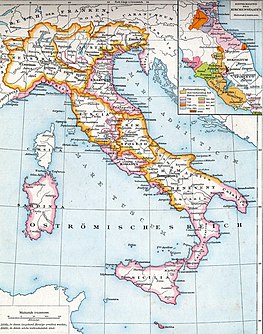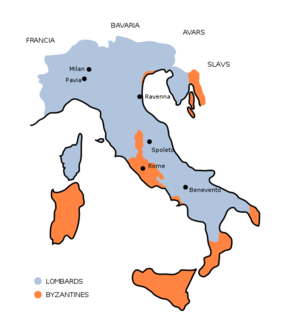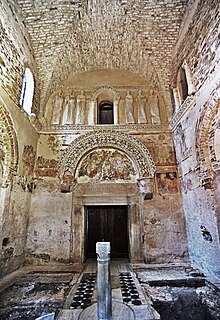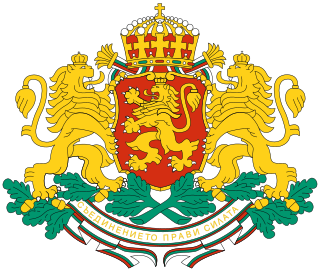Related Research Articles

The Lombards or Langobards were a Germanic people who ruled most of the Italian Peninsula from 568 to 774, with origins near the Elbe in northern Germany and Scania in southern Sweden before the Migration Period.
The 660s decade ran from January 1, 660, to December 31, 669.

Year 662 (DCLXII) was a common year starting on Saturday of the Julian calendar. The denomination 662 for this year has been used since the early medieval period, when the Anno Domini calendar era became the prevalent method in Europe for naming years.

The Carolingian dynasty was a Frankish noble family named after Charlemagne, grandson of mayor Charles Martel and descendant of the Arnulfing and Pippinid clans of the 7th century AD. The dynasty consolidated its power in the 8th century, eventually making the offices of mayor of the palace and dux et princeps Francorum hereditary, and becoming the de facto rulers of the Franks as the real powers behind the Merovingian throne. In 751 the Merovingian dynasty which had ruled the Germanic Franks was overthrown with the consent of the Papacy and the aristocracy, and Pepin the Short, son of Martel, was crowned King of the Franks. The Carolingian dynasty reached its peak in 800 with the crowning of Charlemagne as the first Emperor of the Romans in the West in over three centuries. His death in 814 began an extended period of fragmentation of the Carolingian Empire and decline that would eventually lead to the evolution of the Kingdom of France and the Holy Roman Empire.

King of Italy was the title given to the ruler of the Kingdom of Italy after the fall of the Western Roman Empire. The first to take the title was Odoacer, a barbarian military leader, in the late 5th century, followed by the Ostrogothic kings up to the mid-6th century. With the Frankish conquest of Italy in the 8th century, the Carolingians assumed the title, which was maintained by subsequent Holy Roman Emperors throughout the Middle Ages. The last Emperor to claim the title was Charles V in the 16th century. During this period, the holders of the title were crowned with the Iron Crown of Lombardy.

The Sanctuary of Saint Michael the Archangel is a Roman Catholic shrine on Mount Gargano, Italy, part of the commune of Monte Sant'Angelo, in the province of Foggia, northern Apulia. It has the dignity of a minor basilica.

The Duchy of Benevento was the southernmost Lombard duchy in the Italian Peninsula that was centred on Benevento, a city in Southern Italy. Lombard dukes ruled Benevento from 571 to 1077, when it was conquered by the Normans for four years before it was given to the Pope. Being cut off from the rest of the Lombard possessions by the papal Duchy of Rome, Benevento was practically independent from the start. Only during the reigns of Grimoald, King of the Lombards and the kings from Liutprand on was the duchy closely tied to the kingdom. After the fall of the kingdom, however, it was the sole Lombard territory to continue to exist as a rump state, maintaining its de facto independence for nearly 300 years, although it was divided after 849.
Godepert was king of the Lombards, eldest son and successor of Aripert I. He was an Arian who governed from the ancient capital, Pavia, while his brother, Perctarit, a Roman Catholic, governed from Milan. In a war with his brother, he beckoned Duke Grimoald I of Benevento, who assassinated him in his Pavian palace, the Reggia. Godepert's son Raginpert managed to escape and would later rule, but first, Grimoald would seize the throne.

Perctarit was king of the Lombards from 661 to 662 the first time and later from 671 to 688.
Grimoald or Grimwald was a 7th-century King of Italy, ruling as Duke of Benevento from 647 to 662, and then as King of the Lombards from 662 until his death in 671.

Arechis II was a Duke of Benevento, in Southern Italy. He sought to expand the Beneventos' influence into areas of Italy that were still under Byzantine control, but he also had to defend against Charlemagne, who had conquered northern Italy.

Grimoald III was the Lombard Prince of Benevento from 788 until his own death. He was the second son of Arechis II and Adelperga. In 787, he and his elder brother Romoald were sent as hostages to Charlemagne who had descended the Italian peninsula as far as Salerno to receive the submission of Benevento. In return for peace, Arechis recognised Charlemagne's suzerainty and handed Grimoald over as a hostage.
Grimoald II was the duke of Benevento from 687 to his death. He was the son and successor of Romuald I of Benevento. He was possibly under the regency of his mother, Theodrada, daughter of Lupus of Friuli. His reign of three years was uneventful: Paul the Deacon records nothing but his marriage and death. He is said to have been an opponent of the crown. He was succeeded by his brother Gisulf. He was married to Wigilinda, daughter of King Perctarit.
Gisulf I was the duke of Benevento from 689, when his brother Grimoald II died. His father was Romuald I. His mother was Theodrada, daughter of Duke Lupus of Friuli, and she exercised the regency for him for the first years of his reign.

The Kingdom of the Lombards also known as the Lombard Kingdom; later the Kingdom of (all) Italy, was an early medieval state established by the Lombards, a Germanic people, on the Italian Peninsula in the latter part of the 6th century. The king was traditionally elected by the very highest-ranking aristocrats, the dukes, as several attempts to establish a hereditary dynasty failed. The kingdom was subdivided into a varying number of duchies, ruled by semi-autonomous dukes, which were in turn subdivided into gastaldates at the municipal level. The capital of the kingdom and the center of its political life was Pavia in the modern northern Italian region of Lombardy.
Lupus was the Duke of Friuli from between 660 and 663 to his death around 666.

The Duchy of Friuli was a Lombard duchy in present-day Friuli, the first to be established after the conquest of the Italian peninsula in 568. It was one of the largest domains in Langobardia Major and an important buffer between the Lombard kingdom and the Slavs, Avars, and the Byzantine Empire. The original chief city in the province was Roman Aquileia, but the Lombard capital of Friuli was Forum Julii, modern Cividale.
Barbatus of Benevento, also known as Barbas, was a bishop of Benevento from 663 to 682. He succeeded Ildebrand in this capacity. He assisted in a church council called by Pope Agatho in Rome in 680 and in 681 attended the Third Council of Constantinople against the Monothelites.

The Bulgarians in Italy are one of the sizable communities of the Bulgarian diaspora in Western Europe. There are about 120,000 Bulgarians in Italy according to the Bulgarian government. There are Bulgarian Orthodox parishes in Rome and Milan. Major centres of Bulgarian migration are Milan, Bologna, Florence and Torino.
References
- ↑ Chris Wickham, Early Medieval Italy: Central Power and Local Society, 400–1000 (London: Macmillan, 1981), 38.